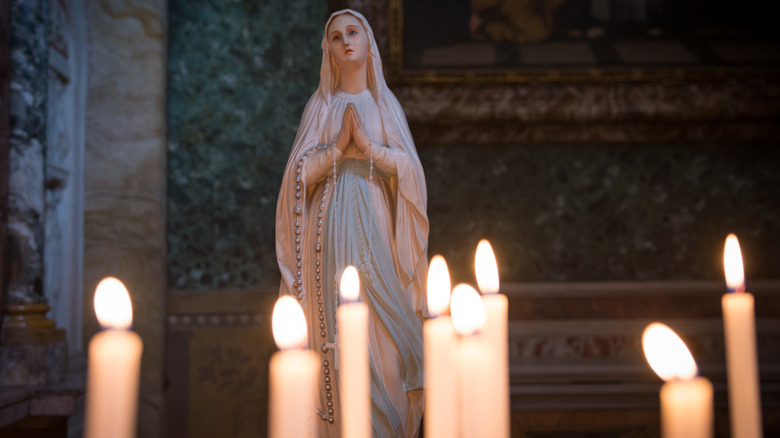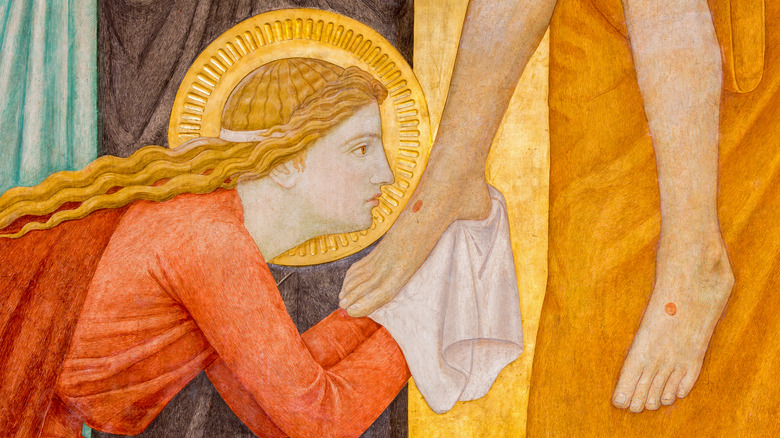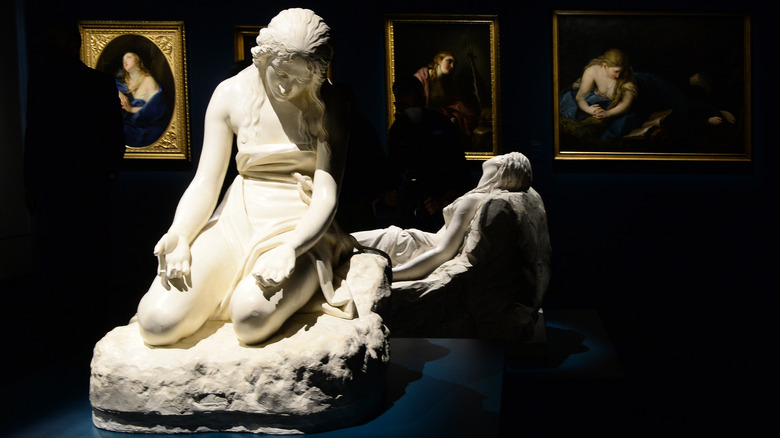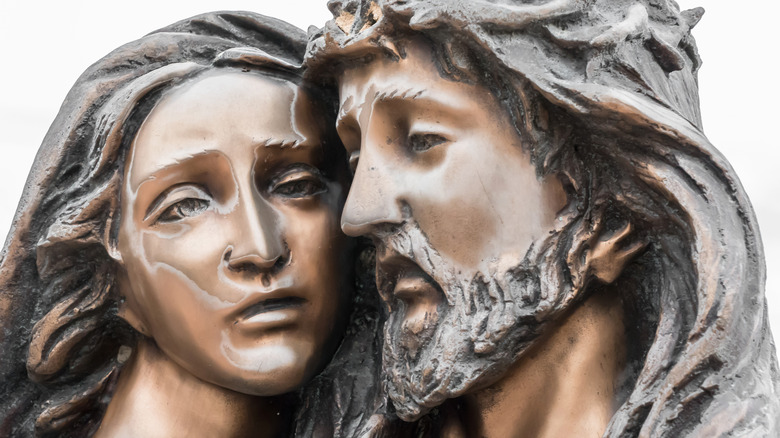What We Know About Jesus' Relationship With Mary Magdalene
If we ask a certain multimillionaire author whose name is Dan Brown, he covered this whole Mary Magdalene mystery thing in 2003's "The Da Vinci Code." According to something-something super secret conspiracy mystery, Magdalene was Jesus' wife and is the actual symbolic Holy Grail because a chalice looks like a womb, and their lineage fostered a secret European medieval bloodline, as sites like Ancient Origins outline. We've also got the Knights Templar, Arthurian Legend, secret tomes, hidden bones, ancient castles, a Vatican coverup, and lots more sensational stuff. In other words, there's no need to wonder why "The Da Vinci Code" sold over 80 million copies. And if you're unfamiliar with any of this stuff: strap in.
That is, you could feel free to strap in if any of the "truth of the relationship between Mary Magdalene and Jesus" talk could amount to anything conclusive. Full disclosure before continuing: It can't. No fact can be absolutely established any more than any conclusion can be definitively stated. Besides, Christian believers will hand-waive all of the above and say, "This changes nothing about the truth of my beliefs, etc., etc." as sure as Magdalenists will say, "You can't see the truth behind your beliefs, etc., etc."
So what do we actually know about the relationship between Jesus and Mary Magdalene? We've only got what various sources say to use to tell various tales of fact or fiction. All of those sources, however, leave out much more than they say.
For the Bible told me so
If there's any "canonical" version — so to speak — of the Mary Magdalene meets Jesus story, it's the Bible's tried-and-true tale. Bear in mind that this article doesn't exist to comment on anyone's cherished faith. Rather, we're retelling what others have told — take the information and do with it what you will.
As Britannica recounts, Mary Magdalene was a kind of recurring character in the four biblical gospels: Matthew, Mark, Luke, and John. Folks familiar with the Bible know that each gospel tells the events of Jesus' life differently, and this includes regarding Mary Magdalene. All in all, she had a number of run-ins with Jesus and was present for some prominent biblical events.
In the Gospel of Luke, chapter 8, Magdalene follows Jesus around the province of Galilee as he goes from town to town teaching, as one woman of several who'd all "been cured of evil spirits and diseases." Luke and Mark both say that "seven demons had come out" of her. After this, Magdalene is mentioned in all four gospels as present during Jesus' crucifixion and burial. John, chapter 19 says she stood by Jesus' cross along with her namesake, Mary the mother of Jesus. Mark, chapter 16 says that she, Salome, and yet another woman named Mary were the first to hear about Jesus' resurrection from an angelic messenger. John, chapter 20 expands on the story and says that Magdalene told this news to Jesus' disciple, Peter.
The Gospel of Mary
We've got to look to extrabiblical sources if we want more Mary Magdalene-Jesus interactions beyond the above-described vignettes. We can start with the "Gospel of Mary," an early Christian text that didn't make St. Jerome's original 400 C.E.-ish Bible cut, as Learn Religions says. The book first came to modern light in 1896 in Cairo, Egypt, when German scholar Dr. Carl Reinhardt bought a fifth-century C.E. version written in Coptic, an Egyptian dialect spoken by early Christians in Egypt, as the Gnostic Society Library explains. It doesn't look like the book was copied after this point, meaning that it might have been actively suppressed.
The Gospel of Mary is sadly incomplete and is missing parts like pages one through six. But as we can read on Gospels.net, there's some interesting stuff in what we've got. Rather than recount direct interactions between Mary and Jesus, the book takes place in the days following Jesus' death and consists largely of conversations between Mary and other of Jesus' followers. In those conversations, Mary recounts talks between her and Jesus largely related to the need for his followers to proselytize. Peter, the well-known disciple, says to Mary, "The Savior loved you more than all other women." Another follower, Levi, says to Peter that, "he [Jesus] loved her more than us" because he "knows her very well." The final point of the book seems to be that, as a woman, Magdalene's prominence in their community shouldn't be questioned.
The Wisdom of Sophia
Documented interactions between Mary Magdalene and Jesus are scant besides the two above-mentioned sources. Some (potential) additional dialogue comes from another non-canonical, early Christian text titled, The Sophia of Jesus Christ, aka, The Wisdom of Jesus Christ, where "sophia" means "wisdom" in Greek. On one hand, this text is just one that happened to survive. No matter attempts at preservation, the Gnostic Society Library also tells us that about 85% of all early Christian writing has been lost. On the other hand, plenty of sites like The Braided Way extrapolate from such texts to infer much more than is stated, especially related to Christian mysticism and the sacred feminine (Dan Brown, we're looking at you). Like always, little is explicitly said, and much is left to interpretation.
The Wisdom of Jesus Christ, like The Gospel of Mary, takes place after Jesus died. This time, though, the text features a single, longish conversation between Jesus and his disciples. Several familiar disciples are mentioned, like Matthew, Thomas, Philip, and so forth. A "Mary" is also mentioned, although it's not stated whether or not she's Mary Magdalene. In the book, she asks questions of Jesus like any other disciple, and is answered like anyone else — there's no special relationship implied. The entire conversation relates to the secrets of the cosmos, Jesus' origins, the nature of eternity, and contains plenty of esoteric proper nouns like the, "First Existent Unbegotten Father," "Spirit-Who-Is," "Confronter," "Lord of the Universe," and, "First Man."
Kisses on the mouth
And so we come to the source responsible for much of the zesty "Jesus and Mary Magdalene were married" talk that resulted in books like "The Da Vinci Code:" The Gospel of Philip, yet another early Christian writing left out of the canonical Bible. Like the other apocryphal books that mention Mary, the Gospel of Philip comes in multiple fragments and languages, as Gospels.net tells us. And like the other books, it's also not certain who the author is.
Regardless, the Gospel of Philip describes Jesus and Mary as physically intimate. The text — readable at the Gnostic Society Library – says that Jesus "used to kiss her often on the mouth," and similar to the Gospel of Mary, says that he "loved her more than all the disciples." Mary Magdalene is also called Jesus' "companion," and it's said that she "always walked" with him. The other disciples are presumably jealous and accuse of Jesus of favoritism, asking, "Why do you love her more than all of us?" Jesus answers them with a mystical word puzzle, saying (amongst other things), "When a blind man and one who sees are both together in darkness, they are no different from one another."
There's also a bit where Mary might be analogized to Wisdom itself, calling her "the barren" and "the mother of angels." Ultimately, however, there's no way to know for certain, and no way to glean answers beyond what the texts say.




